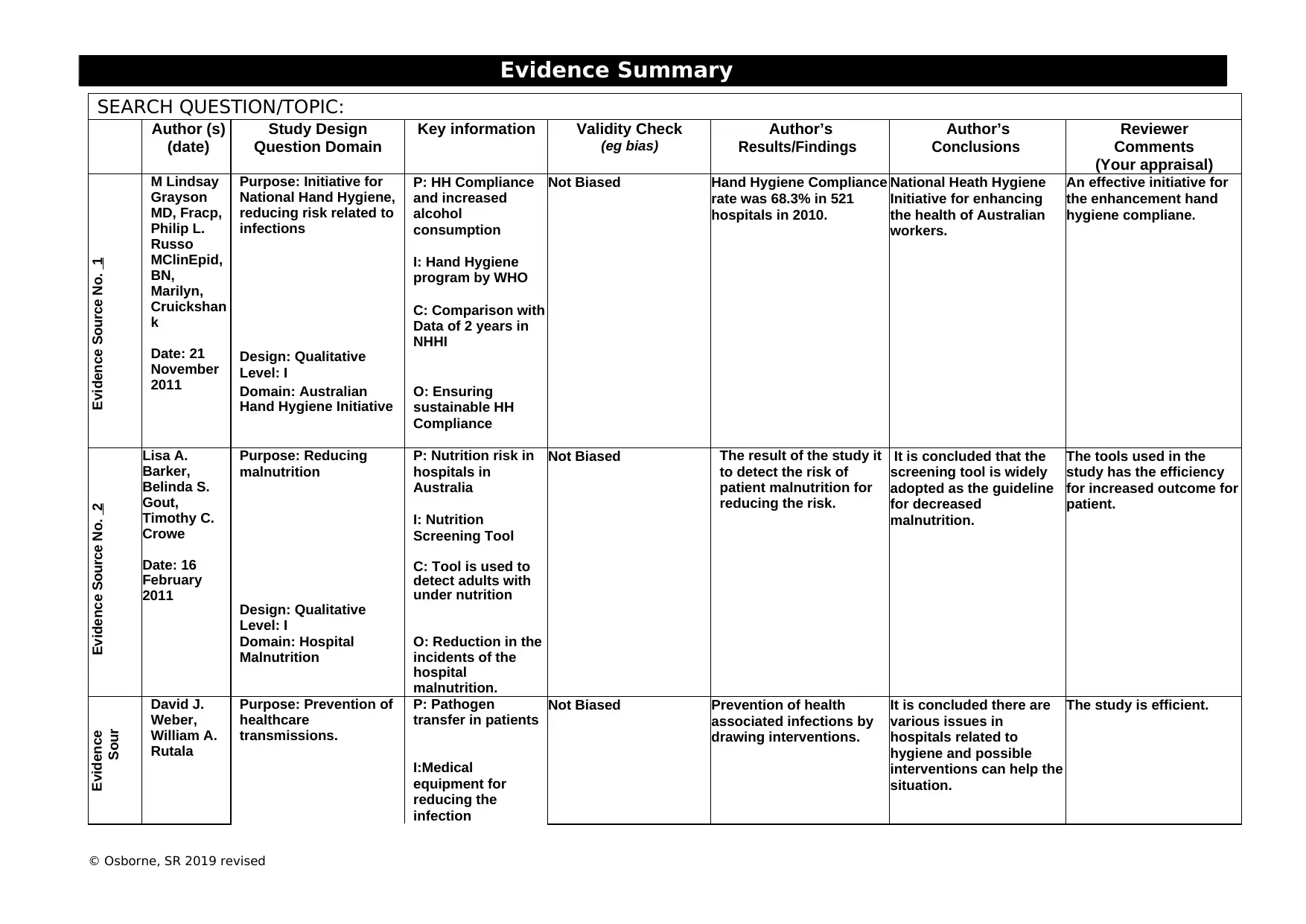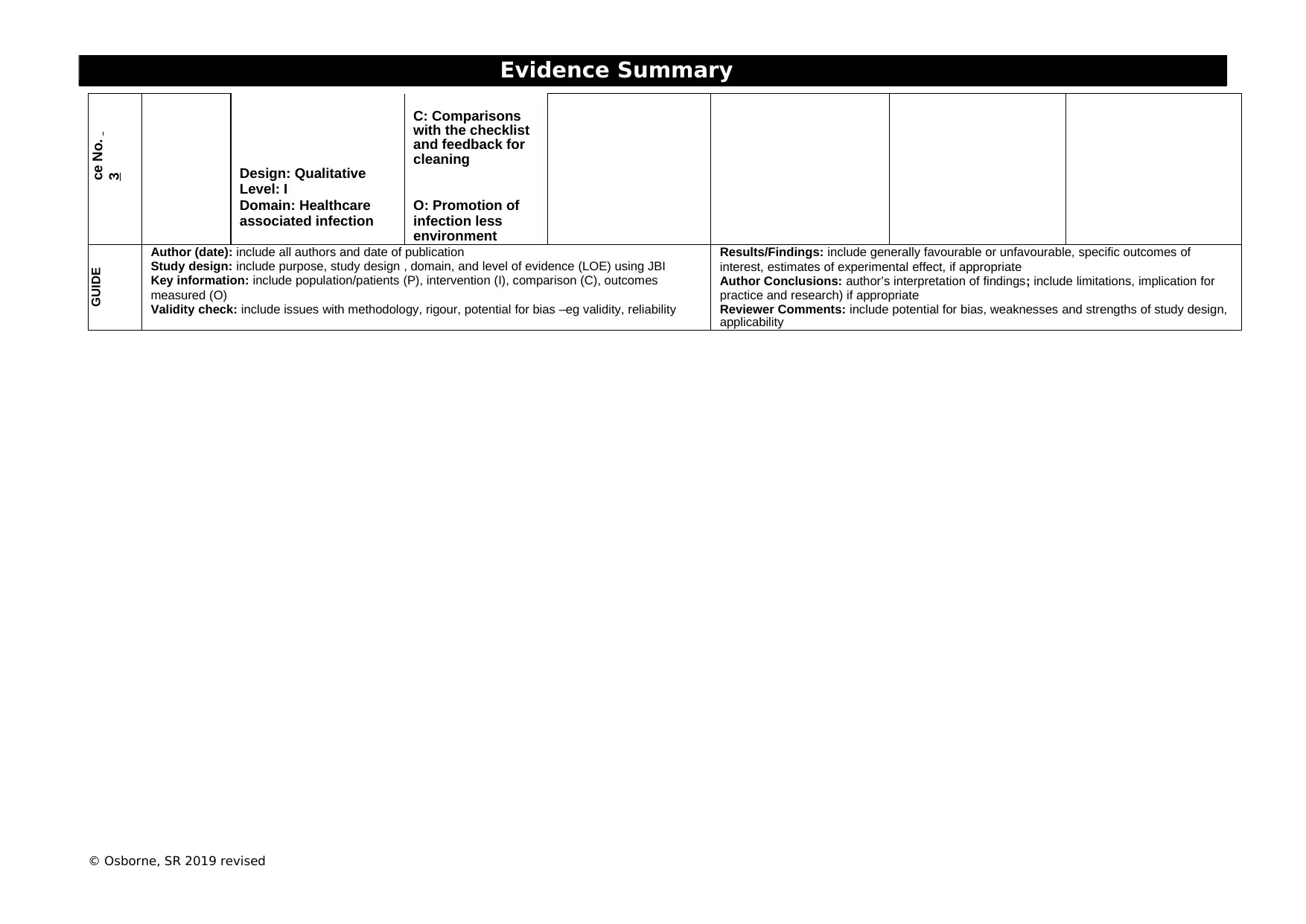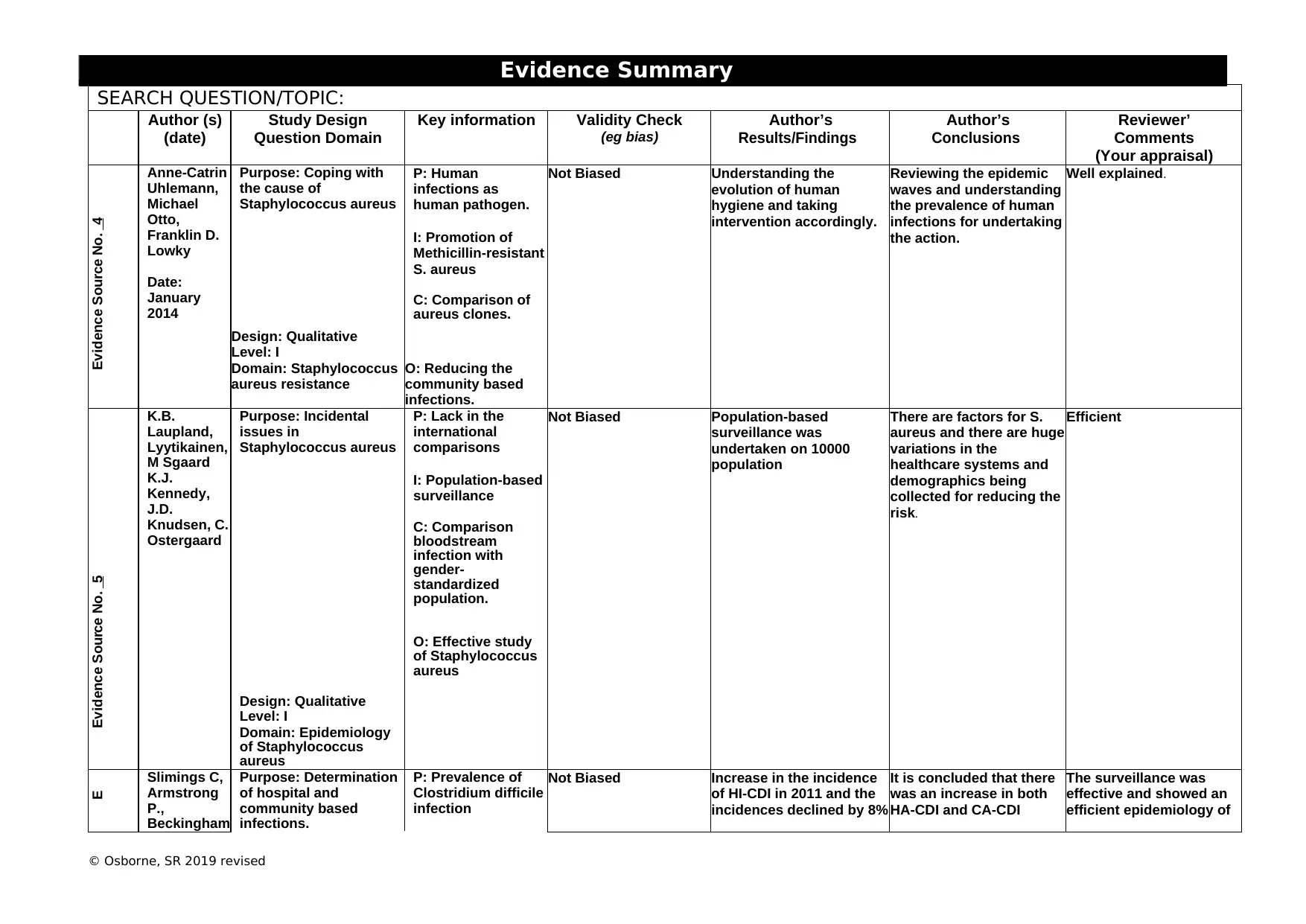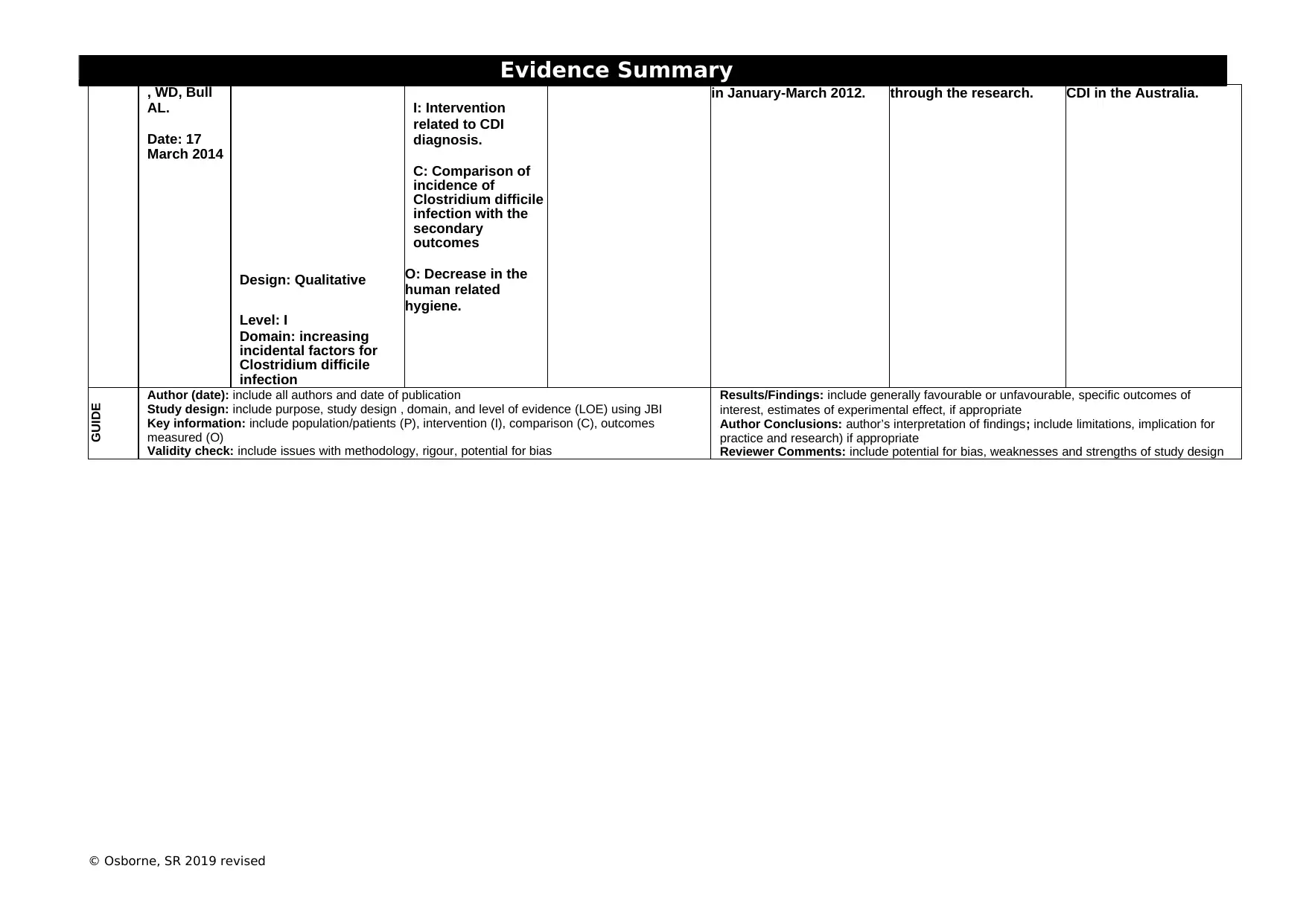NUR2300 Assignment 2: Evidence-Based Nursing Practice Report Analysis
VerifiedAdded on 2022/12/21
|4
|1044
|46
Report
AI Summary
This report presents an analysis of evidence-based nursing practice, focusing on a chosen clinical issue or inconsistent practice observed in a healthcare setting. The report begins by defining the problem and establishing its significance within the context of nursing knowledge and patient care. It then presents a literature review, supported by evidence summary tables of selected research articles, and utilizes the PICO framework for analysis. The report includes articles on hand hygiene, malnutrition, pathogen transfer, and Staphylococcus aureus. Finally, the report synthesizes the research to appraise the highest level of evidence, and offers insights into how evidence-based approaches can inform and improve nursing practice and patient outcomes, aligning with the course learning objectives of NUR2300.

Evidence Summary
Table
© Osborne, SR 2019 revised
SEARCH QUESTION/TOPIC:
Author (s)
(date)
Study Design
Question Domain
Key information Validity Check
(eg bias)
Author’s
Results/Findings
Author’s
Conclusions
Reviewer
Comments
(Your appraisal)
Evidence Source No. 1
M Lindsay
Grayson
MD, Fracp,
Philip L.
Russo
MClinEpid,
BN,
Marilyn,
Cruickshan
k
Date: 21
November
2011
Purpose: Initiative for
National Hand Hygiene,
reducing risk related to
infections
P: HH Compliance
and increased
alcohol
consumption
Not Biased Hand Hygiene Compliance
rate was 68.3% in 521
hospitals in 2010.
National Heath Hygiene
Initiative for enhancing
the health of Australian
workers.
An effective initiative for
the enhancement hand
hygiene compliane.
I: Hand Hygiene
program by WHO
C: Comparison with
Data of 2 years in
NHHI
Design: Qualitative
Level: I
Domain: Australian
Hand Hygiene Initiative
O: Ensuring
sustainable HH
Compliance
Evidence Source No. 2
Lisa A.
Barker,
Belinda S.
Gout,
Timothy C.
Crowe
Date: 16
February
2011
Purpose: Reducing
malnutrition
P: Nutrition risk in
hospitals in
Australia
Not Biased The result of the study it
to detect the risk of
patient malnutrition for
reducing the risk.
It is concluded that the
screening tool is widely
adopted as the guideline
for decreased
malnutrition.
The tools used in the
study has the efficiency
for increased outcome for
patient.
I: Nutrition
Screening Tool
C: Tool is used to
detect adults with
under nutrition
Design: Qualitative
Level: I
Domain: Hospital
Malnutrition
O: Reduction in the
incidents of the
hospital
malnutrition.
Evidence
Sour
David J.
Weber,
William A.
Rutala
Purpose: Prevention of
healthcare
transmissions.
P: Pathogen
transfer in patients
Not Biased Prevention of health
associated infections by
drawing interventions.
It is concluded there are
various issues in
hospitals related to
hygiene and possible
interventions can help the
situation.
The study is efficient.
I:Medical
equipment for
reducing the
infection
Table
© Osborne, SR 2019 revised
SEARCH QUESTION/TOPIC:
Author (s)
(date)
Study Design
Question Domain
Key information Validity Check
(eg bias)
Author’s
Results/Findings
Author’s
Conclusions
Reviewer
Comments
(Your appraisal)
Evidence Source No. 1
M Lindsay
Grayson
MD, Fracp,
Philip L.
Russo
MClinEpid,
BN,
Marilyn,
Cruickshan
k
Date: 21
November
2011
Purpose: Initiative for
National Hand Hygiene,
reducing risk related to
infections
P: HH Compliance
and increased
alcohol
consumption
Not Biased Hand Hygiene Compliance
rate was 68.3% in 521
hospitals in 2010.
National Heath Hygiene
Initiative for enhancing
the health of Australian
workers.
An effective initiative for
the enhancement hand
hygiene compliane.
I: Hand Hygiene
program by WHO
C: Comparison with
Data of 2 years in
NHHI
Design: Qualitative
Level: I
Domain: Australian
Hand Hygiene Initiative
O: Ensuring
sustainable HH
Compliance
Evidence Source No. 2
Lisa A.
Barker,
Belinda S.
Gout,
Timothy C.
Crowe
Date: 16
February
2011
Purpose: Reducing
malnutrition
P: Nutrition risk in
hospitals in
Australia
Not Biased The result of the study it
to detect the risk of
patient malnutrition for
reducing the risk.
It is concluded that the
screening tool is widely
adopted as the guideline
for decreased
malnutrition.
The tools used in the
study has the efficiency
for increased outcome for
patient.
I: Nutrition
Screening Tool
C: Tool is used to
detect adults with
under nutrition
Design: Qualitative
Level: I
Domain: Hospital
Malnutrition
O: Reduction in the
incidents of the
hospital
malnutrition.
Evidence
Sour
David J.
Weber,
William A.
Rutala
Purpose: Prevention of
healthcare
transmissions.
P: Pathogen
transfer in patients
Not Biased Prevention of health
associated infections by
drawing interventions.
It is concluded there are
various issues in
hospitals related to
hygiene and possible
interventions can help the
situation.
The study is efficient.
I:Medical
equipment for
reducing the
infection
Paraphrase This Document
Need a fresh take? Get an instant paraphrase of this document with our AI Paraphraser

Evidence Summary
Table
© Osborne, SR 2019 revised
ce No.
3
C: Comparisons
with the checklist
and feedback for
cleaning
Design: Qualitative
Level: I
Domain: Healthcare
associated infection
O: Promotion of
infection less
environment
GUIDE Author (date): include all authors and date of publication
Study design: include purpose, study design , domain, and level of evidence (LOE) using JBI
Key information: include population/patients (P), intervention (I), comparison (C), outcomes
measured (O)
Validity check: include issues with methodology, rigour, potential for bias –eg validity, reliability
Results/Findings: include generally favourable or unfavourable, specific outcomes of
interest, estimates of experimental effect, if appropriate
Author Conclusions: author’s interpretation of findings; include limitations, implication for
practice and research) if appropriate
Reviewer Comments: include potential for bias, weaknesses and strengths of study design,
applicability
Table
© Osborne, SR 2019 revised
ce No.
3
C: Comparisons
with the checklist
and feedback for
cleaning
Design: Qualitative
Level: I
Domain: Healthcare
associated infection
O: Promotion of
infection less
environment
GUIDE Author (date): include all authors and date of publication
Study design: include purpose, study design , domain, and level of evidence (LOE) using JBI
Key information: include population/patients (P), intervention (I), comparison (C), outcomes
measured (O)
Validity check: include issues with methodology, rigour, potential for bias –eg validity, reliability
Results/Findings: include generally favourable or unfavourable, specific outcomes of
interest, estimates of experimental effect, if appropriate
Author Conclusions: author’s interpretation of findings; include limitations, implication for
practice and research) if appropriate
Reviewer Comments: include potential for bias, weaknesses and strengths of study design,
applicability

Evidence Summary
Table
© Osborne, SR 2019 revised
SEARCH QUESTION/TOPIC:
Author (s)
(date)
Study Design
Question Domain
Key information Validity Check
(eg bias)
Author’s
Results/Findings
Author’s
Conclusions
Reviewer’
Comments
(Your appraisal)
Evidence Source No. 4
Anne-Catrin
Uhlemann,
Michael
Otto,
Franklin D.
Lowky
Date:
January
2014
Purpose: Coping with
the cause of
Staphylococcus aureus
P: Human
infections as
human pathogen.
Not Biased Understanding the
evolution of human
hygiene and taking
intervention accordingly.
Reviewing the epidemic
waves and understanding
the prevalence of human
infections for undertaking
the action.
Well explained.
I: Promotion of
Methicillin-resistant
S. aureus
C: Comparison of
aureus clones.
Design: Qualitative
Level: I
Domain: Staphylococcus
aureus resistance
O: Reducing the
community based
infections.
Evidence Source No. 5
K.B.
Laupland,
Lyytikainen,
M Sgaard
K.J.
Kennedy,
J.D.
Knudsen, C.
Ostergaard
Purpose: Incidental
issues in
Staphylococcus aureus
P: Lack in the
international
comparisons
Not Biased Population-based
surveillance was
undertaken on 10000
population
There are factors for S.
aureus and there are huge
variations in the
healthcare systems and
demographics being
collected for reducing the
risk.
Efficient
I: Population-based
surveillance
C: Comparison
bloodstream
infection with
gender-
standardized
population.
O: Effective study
of Staphylococcus
aureus
Design: Qualitative
Level: I
Domain: Epidemiology
of Staphylococcus
aureus
E Slimings C,
Armstrong
P.,
Beckingham
Purpose: Determination
of hospital and
community based
infections.
P: Prevalence of
Clostridium difficile
infection
Not Biased Increase in the incidence
of HI-CDI in 2011 and the
incidences declined by 8%
It is concluded that there
was an increase in both
HA-CDI and CA-CDI
The surveillance was
effective and showed an
efficient epidemiology of
Table
© Osborne, SR 2019 revised
SEARCH QUESTION/TOPIC:
Author (s)
(date)
Study Design
Question Domain
Key information Validity Check
(eg bias)
Author’s
Results/Findings
Author’s
Conclusions
Reviewer’
Comments
(Your appraisal)
Evidence Source No. 4
Anne-Catrin
Uhlemann,
Michael
Otto,
Franklin D.
Lowky
Date:
January
2014
Purpose: Coping with
the cause of
Staphylococcus aureus
P: Human
infections as
human pathogen.
Not Biased Understanding the
evolution of human
hygiene and taking
intervention accordingly.
Reviewing the epidemic
waves and understanding
the prevalence of human
infections for undertaking
the action.
Well explained.
I: Promotion of
Methicillin-resistant
S. aureus
C: Comparison of
aureus clones.
Design: Qualitative
Level: I
Domain: Staphylococcus
aureus resistance
O: Reducing the
community based
infections.
Evidence Source No. 5
K.B.
Laupland,
Lyytikainen,
M Sgaard
K.J.
Kennedy,
J.D.
Knudsen, C.
Ostergaard
Purpose: Incidental
issues in
Staphylococcus aureus
P: Lack in the
international
comparisons
Not Biased Population-based
surveillance was
undertaken on 10000
population
There are factors for S.
aureus and there are huge
variations in the
healthcare systems and
demographics being
collected for reducing the
risk.
Efficient
I: Population-based
surveillance
C: Comparison
bloodstream
infection with
gender-
standardized
population.
O: Effective study
of Staphylococcus
aureus
Design: Qualitative
Level: I
Domain: Epidemiology
of Staphylococcus
aureus
E Slimings C,
Armstrong
P.,
Beckingham
Purpose: Determination
of hospital and
community based
infections.
P: Prevalence of
Clostridium difficile
infection
Not Biased Increase in the incidence
of HI-CDI in 2011 and the
incidences declined by 8%
It is concluded that there
was an increase in both
HA-CDI and CA-CDI
The surveillance was
effective and showed an
efficient epidemiology of
⊘ This is a preview!⊘
Do you want full access?
Subscribe today to unlock all pages.

Trusted by 1+ million students worldwide

Evidence Summary
Table
© Osborne, SR 2019 revised
, WD, Bull
AL.
Date: 17
March 2014
in January-March 2012. through the research. CDI in the Australia.
I: Intervention
related to CDI
diagnosis.
C: Comparison of
incidence of
Clostridium difficile
infection with the
secondary
outcomes
Design: Qualitative O: Decrease in the
human related
hygiene.
Level: I
Domain: increasing
incidental factors for
Clostridium difficile
infection
GUIDE Author (date): include all authors and date of publication
Study design: include purpose, study design , domain, and level of evidence (LOE) using JBI
Key information: include population/patients (P), intervention (I), comparison (C), outcomes
measured (O)
Validity check: include issues with methodology, rigour, potential for bias
Results/Findings: include generally favourable or unfavourable, specific outcomes of
interest, estimates of experimental effect, if appropriate
Author Conclusions: author’s interpretation of findings; include limitations, implication for
practice and research) if appropriate
Reviewer Comments: include potential for bias, weaknesses and strengths of study design
Table
© Osborne, SR 2019 revised
, WD, Bull
AL.
Date: 17
March 2014
in January-March 2012. through the research. CDI in the Australia.
I: Intervention
related to CDI
diagnosis.
C: Comparison of
incidence of
Clostridium difficile
infection with the
secondary
outcomes
Design: Qualitative O: Decrease in the
human related
hygiene.
Level: I
Domain: increasing
incidental factors for
Clostridium difficile
infection
GUIDE Author (date): include all authors and date of publication
Study design: include purpose, study design , domain, and level of evidence (LOE) using JBI
Key information: include population/patients (P), intervention (I), comparison (C), outcomes
measured (O)
Validity check: include issues with methodology, rigour, potential for bias
Results/Findings: include generally favourable or unfavourable, specific outcomes of
interest, estimates of experimental effect, if appropriate
Author Conclusions: author’s interpretation of findings; include limitations, implication for
practice and research) if appropriate
Reviewer Comments: include potential for bias, weaknesses and strengths of study design
1 out of 4
Related Documents
Your All-in-One AI-Powered Toolkit for Academic Success.
+13062052269
info@desklib.com
Available 24*7 on WhatsApp / Email
![[object Object]](/_next/static/media/star-bottom.7253800d.svg)
Unlock your academic potential
Copyright © 2020–2025 A2Z Services. All Rights Reserved. Developed and managed by ZUCOL.





